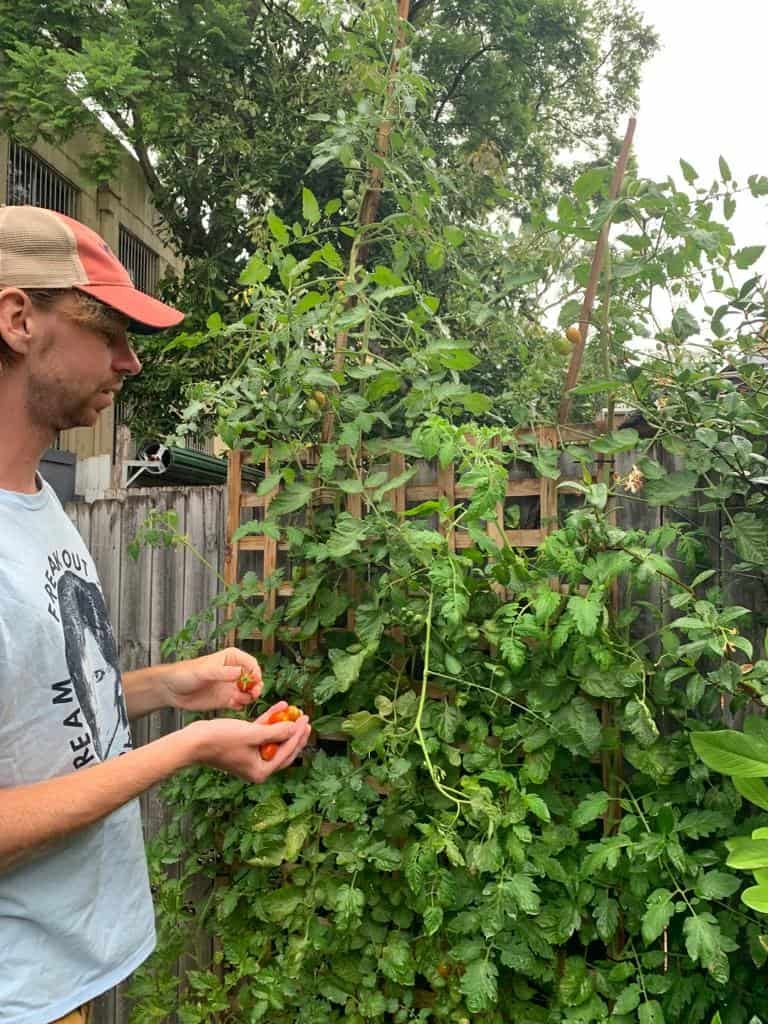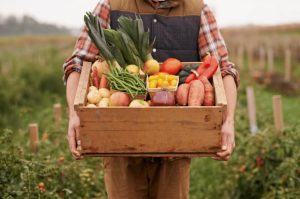Growing tomatoes in Sydney isn’t just about tossing seeds into the soil and hoping for the best; it’s an art form of patience, care, and insight into the whims of weather patterns.
In this guide, we’ll walk you through every step needed to grow tomatoes successfully in Sydney, from selecting the right varieties that flourish in this unique climate to reaping the bountiful harvest when conditions align perfectly.
What are the best tomatoes to grow in Sydney?
Due to its warm summers and mild winters, Sydney’s climate can be quite kind to tomato growers. The key is finding varieties resilient enough to handle sudden changes while thriving during optimal conditions.
Some tomato types that have consistently proven suited for Sydney gardens that we prefer include:
- Tommy Toe: Cherry-like sweetness packed within small fruits; highly productive.
- Grosse Lisse: A popular variety known for reliable cropping and classic tomato flavour.
- Roma VF: Great for cooking due to their thick flesh and lower moisture content.
- Beefsteak: Impressive size makes them perfect for sandwiches or as stand-alone dishes.
Each variety brings something special, from their robust flavours to their hearty resilience against local pests. Check out our other growing guide to learn more about what vegetables to grow in Sydney.

Determinate vs indeterminate tomato varieties and their suitability for Sydney
When diving deeper into suitable selections, we must differentiate between determinate and indeterminate tomato plants because each has pros and cons based on your gardening approach:
Determinate tomatoes, also called bush tomatoes, grow until a certain point and then stop. After they produce a flush of fruit, they’re done for the season. Some advantages of determinate tomatoes include:
- A more compact growth pattern fits well with limited space.
- A predetermined fruiting period means all your harvesting could happen simultaneously, which is ideal if you plan to make sauces or preserves!
However, they usually require more initial work simultaneously due to concentrated harvesting time.
Meanwhile, indeterminate tomatoes continue growing like enthusiastic vines throughout their lifespan. They will happily produce fruit until killed by frost or disease. The upsides that we enjoy with these are:
- Continuous yield across several months. It allows fresh pickings frequently over the summer.
- Potentially larger plants result in higher overall yields if maintained properly.
Then again, they require staking or caging due to their sprawling habit, which adds extra maintenance tasks during growth periods.
For most Sydneysiders growing tomatoes, indeterminate types often become favourites since our mild winter means extended growing seasons, letting those little (or big!) beauties give us delicious gifts time and again.
When to plant tomatoes in Sydney
Knowing when to plant tomatoes in Sydney is critical for the best results. In our experience, we follow two main planting timeframes that provide the best results:
- Spring planting: As the chill of winter dissipates, it’s time to think about your tomato garden. In spring, specifically from late August to early September, give or take a few weeks, depending on how mild the winter was.
- Summer planting: You can also sneak in another round quickly! December is your last chance before it gets too hot. Ensure enough time for your plants to fruit before any cold snap.
Launching into action during these periods provides your tomato plants with ample warmth and decreases the chances of frost damage. It also allows them to establish robust roots before they lavish their energy on producing those delicious red orbs we all love!

Note on watching the weather wisely
Still, while dates offer guidance, they aren’t infallible.
Our advice? Keep an eye on the weather forecasts. Unseasonable cold snaps or heat waves will throw off even the best-laid plans. If you observe that winter lingers longer than usual or if an early heatwave crashes onto Sydney shores, adjust accordingly.
Soil temperature holds equal importance; tomatoes have an affinity for warm soil. A nifty trick we’ve picked up involves measuring the soil temperature using a simple thermometer: aim for consistent readings above 16°C for safe planting.
Remember this gardening mantra: vigilant observation over rigid schedules every time!
How to plant tomatoes for Sydney climates
Having a good start with healthy soil means healthier plants and an abundant harvest down the line. Tomatoes are versatile, but they demand well-drained, nutrient-rich soil to flourish. Let’s delve into what makes up the perfect bed for your tomato plants:
- pH level: Tomatoes prefer slightly acidic to neutral soil, aiming for a pH between 5.0 and 6.5.
- Texture: Loamy soil that holds moisture without becoming waterlogged provides an ideal environment.
- Nutrient content: Compost or aged manure can boost the fertility of your soil, supplying essential nutrients like nitrogen, phosphorus, and potassium.
Additionally, we recommend following these steps with your soil before planting your tomatoes:
- Testing the soil: Kick things off by testing your soil; simple kits from local garden stores will reveal pH levels and key nutrients.
- Clear the bed: Begin with removing weeds and debris; these uninvited guests rob nutrients and space from your tomatoes.
- Amendment time: Generously work through compost or rotted manure—around 2-4 inches worth—to enrich the earth.
- Adjust the pH: If needed, sprinkle lime over acid-heavy soils or sulphur over alkaline soils to balance the pH levels.
- Tilling it up: Till everything together to integrate amendments into the top 6-8 inches where roots actively grow–but avoid overly disturbing the soil structure!
Rest assured, with each shovel turn, you’re setting up your tomatoes for success!
Planting tips and techniques
As you prepare to get your hands dirty and bring those ripe, juicy varieties to life, let us guide you through some techniques that’ll help maximise growth:
- Start with healthy seedlings: When selecting your tomato seedlings, choose those with robust green colouring and sturdy stems. Weak or leggy seedlings often struggle to keep up once transplanted.
- Mind the depth: Tomatoes thrive when planted deeply. The ideal planting technique involves burying them up to their first true leaves after you’ve removed the lower leaves gently. This encourages a stronger root system as they grow roots throughout their buried stems.
- Spacing is key: Proper spacing prevents overcrowding, which helps with air circulation and reduces disease risk. Here’s what you need to remember:
- For determinate (bush-type) varieties, space them about 45 cm apart.
- Indeterminate (vining) types should be given more room; space them at least 60 cm apart.
Considering these points ensures that each plant has sufficient space for its foliage and its root system beneath the soil.
By following these straightforward but significant tips on planting techniques suitable for our local climate here in Sydney, you’re laying down a strong foundation that cultivates a thriving garden packed with vibrant tomatoes.
Remember that consistency is as important as starting off well. Pay regular attention to your burgeoning plants as they blossom under your care!
Watering tomatoes in Sydney
When you are growing tomatoes in Sydney, understanding the specific needs of your plants is essential to foster a generous yield come harvest time. Watering becomes crucial for vibrant, fruit-bearing plants, with the city’s climate ranging from warm summers to mild winters.
We recommend following this watering routine if you’re located in Sydney:
- Morning watering: It’s best to water early in the morning. This allows plants to absorb moisture before the harsh midday sun evaporates it.
- Deep watering: Implement deep watering sessions rather than frequent shallow ones. Deep watering encourages stronger root systems, which contribute immensely to plant health.
- Consistency is key: Keep soil moisture consistent, but beware of overwatering, which could lead to root rot or fungal diseases.
- Mulching: Use mulch around your plants to retain soil moisture and reduce temperature fluctuations that stress your tomatoes.
As we’ve found through our own experiences, drip irrigation or soaker hoses maximise efficiency by delivering water directly to the roots and minimising evaporation. Moreover, abstain from overhead watering as wet foliage invites disease.

Appropriate fertilisers and feeding schedules for tomatoes
Feeding your tomato plants isn’t just about loading them with nutrients; it’s also about timing and balance.
Here are some targeted approaches:
- Begin with soil testing: Start by getting your soil tested—know what you’re working with so you can supplement accordingly.
- Type of fertiliser: Opt for a balanced fertiliser initially (like a 10-10-10 NPK) when planting. As fruits begin forming, switch to one higher in phosphorus and potassium (5-10-10).
- Application frequency: Feed young tomato seedlings lightly, as too much can burn the roots. When they are more established, we recommend using half-strength liquid fertiliser every two weeks. This will avoid shock while providing steady nutrition.
- Remember: Synthetics offer quick fixes, whereas organics release slowly, making them gentler on your plant’s system. They effectively mirror nature’s pace.
Watch as you navigate through different growth stages for cues from the plant itself. Yellow leaves often signify nutrient deficiency, indicating it might be time for a feed dose adjustment.
Controlling pests and diseases in your tomato plants
Growing tomatoes in Sydney brings its unique set of challenges, particularly when it comes to managing pests and diseases. These can greatly affect crop yield and quality if not addressed promptly and effectively.
Tomato growers in Sydney will often find themselves up against various pests such as aphids, whiteflies, and the dreaded fruit fly. Alongside these critters are diseases such as powdery mildew, blossom end rot, and various fungal infections like early blight, which thrive in our warm, humid conditions.
Here are some typical threats:
- Aphids: These sap-sucking insects can multiply rapidly, weakening plants and spreading disease.
- Whiteflies: Similar to aphids in damage, they can also cause yellowing leaves and stunted growth.
- Fruit Flies: They lay their eggs into ripe or ripening tomatoes, causing spoilage.
- Blossom End Rot: This is not an infection but a disorder caused by calcium deficiency, often exacerbated by inconsistent watering.
- Early Blight: Noticed by dark spots on leaves; this fungus attacks tomatoes from mid-season onwards.
Understanding what you’re up against gives you insight into the preemptive measures to take for healthy tomato plants.
Organic methods for pest control and disease prevention
When tackling these pesky invaders organically, maintaining a strategy that focuses on prevention is paramount–healthy plants have better defences.
Below, we’ve outlined some proven tactics that’ll nurture robustness within your crops while warding off unwelcome visitors:
- Encourage beneficial insects: By planting compatible flowers nearby or creating insect hotels, you attract predators like ladybugs, which feast on aphids.
- Use neem oil sprays: Neem oil is effective against various pests without harming beneficial insects when used correctly; remember to apply it during cooler parts of the day to avoid leaf burn.
- Implement proper watering techniques: Water at the base of the plant to keep foliage dry, thus offering less invitation for fungal spores that demand wet conditions to germinate.
- Rotate crops yearly between different garden beds: Don’t plant tomatoes consecutively in the same soil, as pathogens build up over time.
Additionally, concoct home remedies such as garlic or chilli spray, which serve as deterrents due to their strong odours, an offer most pests would rather refuse.
By integrating these organic practices into your care routine when growing tomatoes in Sydney, you bolster your frontline defence substantially against those natural adversaries eager to enjoy your harvest just as much as you do.
Not only does your garden become a more harmonious ecosystem through these tactics, but it also radiates vitality all season long!
Pruning your tomato plants
Pruning helps direct the plant’s energy towards fruit production rather than excessive leaf growth. It improves air circulation, reducing the risk of fungal diseases, which can be challenging in our sometimes humid climate.
Before diving into the specifics of pruning, it’s crucial to understand the type of tomato plant you’re nurturing in your Sydney garden:
- Determinate varieties, known for their predetermined growth limit, produce all their fruit simultaneously and require minimal pruning, mainly to remove any diseased or dead foliage.
- Indeterminate varieties, which grow and fruit throughout the season, demand more regular pruning to manage their growth and boost fruit production.
Regardless of the variety, timing plays a pivotal role in pruning. The ideal moment to start is when your tomato plant reaches about 30-60 cm in height or has developed several leaf branches. It’s also important to regularly inspect your plants throughout the growing season, paying extra attention during summer to ensure they remain healthy and productive.
When it comes to pruning your tomatoes, try following these steps:
- Remove suckers: These are small shoots that appear in the axils (the angles between the main stem and the branches). For indeterminate varieties, pinch off suckers while they are small, ideally less than 7.5 cm in length. This redirects energy to the main stem and developing fruit.
- Lower leaves: Remove the lower leaves, especially those touching the ground, to prevent soil-borne diseases. As the plant grows, remove the bottom leaves to maintain about 30 cm of clear stem.
- Aerate the centre: Thin-out interior branches for better air circulation and light penetration.
- Top the plant: As the end of the season approaches, especially if you notice a lot of small fruits that won’t ripen in time, consider topping the plant. This means cutting off the top portion to stop upward growth, allowing the plant to focus on ripening existing fruits.
By incorporating these pruning practices, gardeners in Sydney can look forward to healthier plants and more abundant tomato harvests. Remember, each plant is unique. Use these guidelines as a starting point and adapt based on your observations and experiences in your garden.
Different staking methods to support tomato plants
When growing tomatoes in Sydney, choosing a staking method is essential for keeping plants upright and healthy. It improves air circulation, reduces disease risk, and makes harvesting easier. Here’s an overview:
- Single-stake method: Drive a sturdy stake into the ground next to the plant and tie stems loosely with soft twine as they grow. This simple technique suits indeterminate varieties that continue growing throughout the season.
- Cage method: Tomato cages are conical wire structures placed around each plant. They support growth naturally without constant tying. These work well for determinate types which grow to a set size.
- Trellis system: For larger tomato patches, trellises can be highly effective. Secure horizontal wires or strings above plants to attach vines using clips or ties. The trellis system optimises the usage of space and sunlight, enhancing overall production.
- Florida weave: A clever choice for lengthy rows of tomatoes. Drive posts at intervals along the row’s length, then weave twine around them along both sides of the plants. As they get taller, add more levels of twine.
Over time, we have found that experimenting with different methods helps understand what works best for your garden setup and the particular habits of various tomato cultivars in Sydney.
Support schemes should be installed at planting time or soon after so as not to disturb root systems later. Also, you choose supports that are durable enough to withstand Sydney’s weather conditions throughout the growing season. Flimsy materials may crumble under our occasional gusty winds and sporadic summer storms.
Incorporating these staking tricks into your gardening routine will stand you in excellent stead as you strive for those juicy red fruits that embody summer satisfaction!

Harvesting and storing tomatoes in Sydney
The culmination of diligent care, from seedling to fruit-bearing plant, is the joyous moment of harvesting ripe tomatoes.
Eager anticipation often accompanies the ripening phase of tomatoes. Watch for these telltale signs to know when your tomatoes are ready:
- Colour transformation: The ubiquitous hint that a tomato has matured is its colour shift. Your green little friends will begin to take on vivid hues, deep reds, sunny yellows or even purply blacks- indicating peak ripeness.
- Slight softness: Gently squeeze the fruit; a ripe tomato will yield slightly under pressure, having a tender yet plump feel.
- Easy stem release: If a tomato separates easily from the stem with a slight twist, it’s usually an indicator that it’s time for harvest.
- Fragrance: A ripe tomato emits a distinct sweet and earthy aroma that remains unmatched by those still maturing on the vine.
Not all varieties change colour dramatically upon ripening; some heritage strains or heirlooms may retain greenish shoulders even when fully mature.
How to harvest your tomatoes
Harvesting tomatoes is as much an art as a science, a culmination of months of care and attention. In Sydney’s unique climate, following these steps will ensure you harvest your tomatoes at the perfect moment, preserving their flavour and extending their shelf life:
- Choose the right time of day: Aim to harvest in the early morning when temperatures are cooler. This helps in retaining the fruit’s natural moisture and freshness.
- Use the right technique: Gently hold the fruit and twist it lightly from the vine. If it’s ripe, it should come off easily. Avoid pulling directly, as this can damage the plant and the fruit.
- Harvest regularly: Check your plants every couple of days. Regular harvesting encourages the plant to produce more fruit and reduces the burden on the plant.
- Use sharp scissors or pruners: For tomatoes that are a bit stubborn or for varieties with thicker stems, use a pair of clean, sharp scissors or pruners to make a clean cut. This prevents damage to the plant and the remaining fruit.
- Handle with care: Tomatoes bruise easily. Handle them gently and place them in a basket or container to avoid piling them on top of each other.
- Inspect for ripeness: As you harvest, inspect each tomato for ripeness using the signs mentioned earlier – colour, softness, stem release, and fragrance.
- Leave some stem: If possible, attach a small part of the stem. This can help in prolonging the shelf life of the tomato.
- Don’t forget the late bloomers: At the end of the season, you can also harvest green tomatoes. These can be ripened indoors or used in recipes that call for green tomatoes.
By following these steps, you’ll ensure that each tomato you harvest from your Sydney garden is at its peak, ready to be savoured fresh or stored for later use.
Proper storage techniques to prolong shelf life of harvested tomatoes
Once picked, proper storage methods can enhance both flavour retention and longevity. Here are strategies tailored specifically for successful tomato storage in Sydney:
- Counter-top ageing: Store newly harvested tomatoes at room temperature, far away from direct sunlight, if they need to ripen further. Avoid refrigerating unless they’ve been cut, as cold temperatures can mute flavours and lead to spongy textures.
- Sequential usage: Organise your stash based on ripeness – use the softer, more colourful ones first while allowing firmer ones extra time to reach their zenith.
- Breathable containers: To avoid moisture buildup (a leading cause of mould), opt for baskets or boxes that allow air circulation rather than sealing them in plastic bags.
- Individual spaces: If possible, give each tomato space; this limits decay spread should one start going bad sooner than its counterparts.
When properly executed, these techniques will help maintain optimal condition until you’re ready to indulge or impress with your fresh-from-the-garden delights. Remember that eventually, all good things must end, so don’t hesitate too long before celebrating nature’s bounty either directly off the vine or within your favourite recipes!
Final thoughts
Embracing these practices, from selecting the right varieties to mastering pruning and harvesting techniques, sets you on a rewarding gardening journey. Remember, each tomato plant in your garden is a testament to your dedication and love for gardening. As you apply these tips, relish nurturing and watching your plants thrive.
May your harvest be plentiful and your gardening experiences enriching. Here’s to the joy of homegrown tomatoes, bursting with flavour, in your very own Sydney garden! If you’re not from Sydney, see our other guides on growing tomatoes in Adelaide, Perth or Melbourne!
FAQs
Can you grow tomatoes all year round in Sydney?
Growing tomatoes year-round in Sydney is challenging due to varying seasonal conditions. The city’s warm summers and mild winters are ideal for tomato cultivation, but the cooler winter months can hinder growth. For year-round cultivation, consider using greenhouses or indoor setups with controlled environments.
If you’re in the market for a greenhouse, check out our comprehensive review on the best products in the Australian market!
Can you grow tomatoes in Sydney in winter?
Growing tomatoes in Sydney during winter is possible but requires extra care. The cooler temperatures can slow growth, so protective measures like greenhouses or cloches are advisable. Selecting cold-tolerant varieties and ensuring adequate sunlight can also help in successful winter cultivation.
What are the best tomatoes for beginners to grow?
For beginners, cherry tomatoes like ‘Tommy Toe’ and ‘Sweet 100’ are excellent choices due to their ease of growth and resilience. Bush varieties like ‘Roma’ and ‘San Marzano’ are also beginner-friendly. They require less staking and pruning, making them ideal for new gardeners.
Where is the best place to grow tomatoes?
The best place to grow tomatoes is in a sunny, well-ventilated spot with at least 6-8 hours of direct sunlight daily. Ensure the soil is well-drained and nutrient-rich. Raised beds, containers, Vegepods or Food Cubes, and even a spot in your garden that receives ample sunlight and has good air circulation are all ideal.
How long do tomatoes take to grow?
Depending on the variety, tomatoes typically take about 60-100 days to grow from planting to harvest. Cherry tomatoes usually mature faster, while larger varieties like beefsteak may take longer. Factors like climate, care, and tomato type influence the growth duration.






